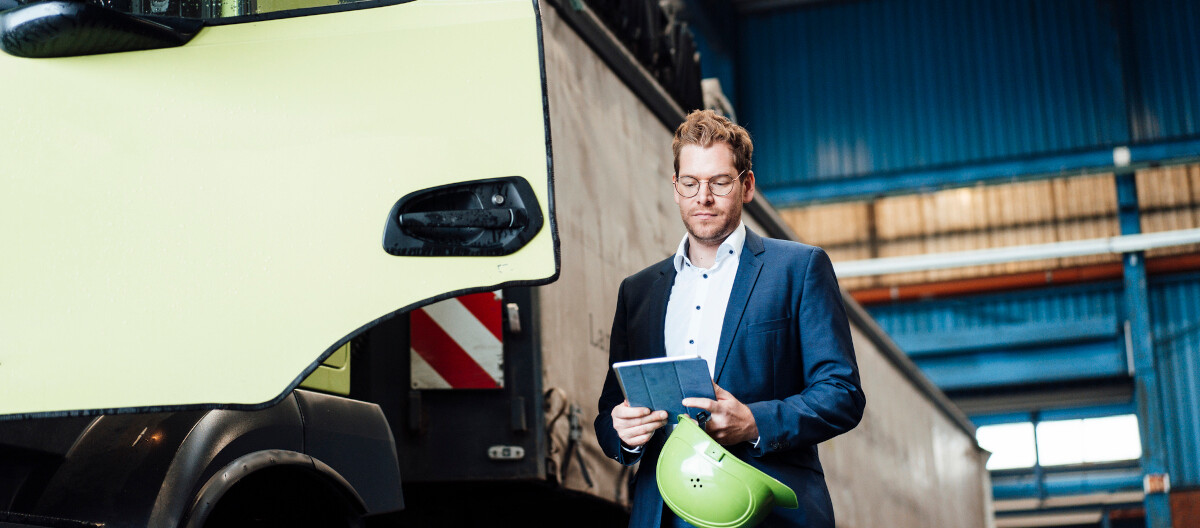What are sensor-based telematics systems?
The term “telematics” combines the words “telecommunications” and “informatics”. Telematics systems in vehicles usually collect various data, such as GPS position, speed, fuel consumption or tyre pressure, automatically by means of special telematics boxes. Safety-relevant data, such as malfunctions or braking patterns, can also be recorded and then transmitted. Software platforms then visualise this data clearly on dashboards.
Such telematics systems are long-established in modern fleet management. However, there are also telematics systems that can collect considerably more data with the help of special sensors. These sensor-based telematics systems offer numerous advantages, especially in freight transport. Telematics sensors in refrigerated trailers, for example, are responsible for monitoring the temperature or checking the performance of the cooling unit. In addition to temperature sensors, other types of sensors – for example, pressure sensors or state of charge sensors – may also be used. Transport risks can thus be measured and better identified.
The high costs of transport damage
Transport damage in the UK has been at a high level for years. It’s estimated that returns of consumer goods due to damage cost UK retailers £60 billion in 2016, £20 billion of which came from online purchases. According to Packaging Digest, up to 11% of unit loads arriving at a distribution centre have some level of case damage. And the impact on B2B suppliers is also considerable: equipment, parts or components damaged in transit can lead to a significant amount of wasted time. In addition, it can slow down not only the company’s own supply chain, but that of their clients, which has a detrimental effect on business relationships.
There are eight main causes of equipment damage in transit: impact, vibration, moisture, dust, temperature and humidity, poor handling, static charges, and unsuitable packaging. The most prevalent of these – impact – is frequently caused by mishandling, collisions during transit, or inadequate load securing. An insecure load is a breach of the requirement to maintain a vehicle in a fit and serviceable condition, and can pose a considerable security risk to other road users. In 2013 the Driver Vehicle Standards Agency (DVSA) issued over 2,000 prohibitions to vehicles which presented a road safety risk due to inadequate load securing, an offence which carries a maximum penalty fine of £2,500. Following a fatal accident in 2021, new guidance on load securing was issued. For the reasons listed above, prevention of transport damage through sensor-based telematics systems is becoming increasingly relevant.
Smart sensor telematics: specific applications
Sensor-based telematics systems are already being used by various logistics companies and freight carriers for specific routes and products. For example, sensors inside tyres to measure filling pressure and temperature are now well-established. In case of any discrepancies, the system informs the recipient. This minimises flat tyres, reduces inspection costs, and increases the safety of both goods and drivers.
In conjunction with augmented reality (AR), cameras and sensors can even be used to compare the actual status of an HGV with the target state before the journey starts, so that potential hazards can be eliminated preventively. Cameras and sensors can also check how much space is still available in the HGV's interior by measuring the cargo that has already been loaded and determining the remaining volume to ensure efficient loading.
When the load is being secured, special telematics systems can also give the driver prompts which must be explicitly acknowledged and cannot be bypassed. In this way, the driver cannot neglect important transport safety measures, either accidentally or deliberately. At the same time, this allows load securing to be automatically documented in accordance with legal requirements.
Present your company on our platform!
The advantages:
- International audience and visibility
- Set-up in 5 minutes
- Numerous options and services through individual content
Best practice: ShockWatch impact sensors and impact monitors
ShockWatch UK has a 20-year track record of providing impact devices which detect shipment damage during transit. The company specialises in products which measure impact, temperature and tilt, as well as labels with a highly visible ‘red alert’ to warn handlers of possible damage. Products are designed for specific weight classes to ensure proper impact measuring. The ShockLog range of impact monitors includes satellite, cellular, and USB options. All models are available with temperature and humidity functions, with the top of the range also featuring an internal tilt and roll sensor and internal GPS.
The impact sensor contains a mechanical indicator and an RFID chip. When goods are scanned remotely by an RFID reader, their condition is entered automatically into the enterprise resource planning (ERP) software or warehouse management system. This means that large quantities of packages can be read and evaluated for damage in seconds, without the need to physically inspect the RFID tag. Monitoring goods in transit or storage in this way has been shown to reduce damage by 40-60%.


